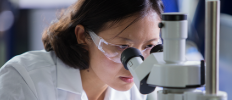Preserving the Waterway that Helped Build America
June 2015
A Simple Goal for a Complex Solution
 PM USA's Park 500 facility sits on the banks of a quiet part of the James River, surrounded mostly by farmland. The ISO 14001 certified facility is like a large recycling operation, using small bits of tobacco from our cigarette manufacturing facility to create tobacco sheets for use in cigarette production. This process uses up to 1.8 million gallons of water each day. We treat this wastewater on-site through a natural treatment system and then return it to the James River.
PM USA's Park 500 facility sits on the banks of a quiet part of the James River, surrounded mostly by farmland. The ISO 14001 certified facility is like a large recycling operation, using small bits of tobacco from our cigarette manufacturing facility to create tobacco sheets for use in cigarette production. This process uses up to 1.8 million gallons of water each day. We treat this wastewater on-site through a natural treatment system and then return it to the James River.
In 2002, PM USA reviewed all aspects of its wastewater treatment plant to improve Park 500’s environmental performance. The goal was remarkably simple: explore creative ways to reuse or recycle the facility’s wastewater to reduce nitrogen, phosphorous and other oxygen-robbing nutrients. Arriving at an effective solution, on the other hand, was a complex and collaborative process involving PM USA employees, outside experts and a local research university.
In 2006, PM USA designed and built a natural treatment system on 48 acres of engineered wetlands along the banks of the James. Although this approach wasn’t a zero-discharge design, the plants in the wetlands would absorb nutrients in the wastewater, create a new habitat for wildlife and help strengthen the health of the James for future generations. PM USA completed the project in 2008.
The nutrient reductions help the Altria family of companies reduce its environmental impact and make progress toward its long-term goals.
A Place for Plants and Wildlife to Thrive
The wetlands include 22 plant species key to the nutrient removal process and more than 150,000 plants, like water lily, pickerelweed and soft stem bulrush, along with hundreds of native shrubs and nearly 1,300 hardwood and evergreen trees serving as a riparian buffer. The wetlands serve as the finishing phase to our waste treatment water and harness nature to reduce nutrient discharge and the environmental impact on the James and ultimately the Chesapeake Bay. Global Water Intelligence recognized this innovative wastewater treatment approach as a finalist for the 2010 Industrial Water Project of the Year.
Today, the wetlands are a learning laboratory. Students and environmental researchers can see state-of-the art sustainability projects in an industrial setting and observe wildlife, including mammals, birds, reptiles, amphibians and insects repopulating the area.
The facility participates in the Virginia Nutrient Credit Exchange, which coordinates and facilitates nutrient credit trading among its members to improve Chesapeake Bay watershed water quality. In 2017, PM USA received a $75,800 payment within the Exchange for the exchange of nitrogen credits.











